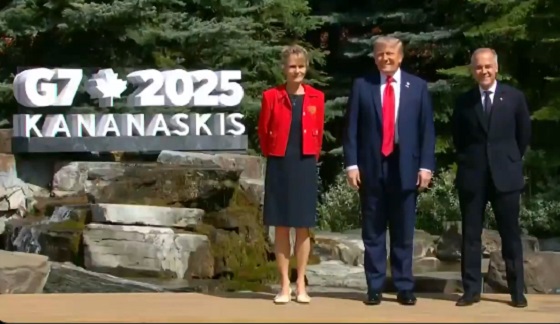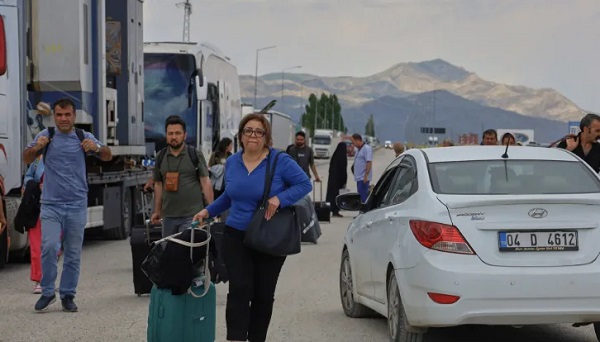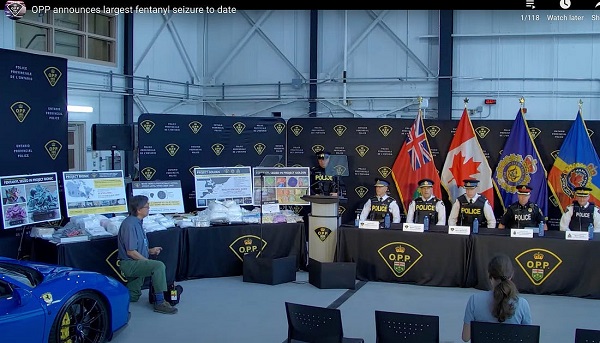International
Trump arrives in Canada for high-stakes G7 summit

 MxM News
MxM News
Quick Hit:
President Trump arrived Monday for the G7 Summit in Alberta—his first visit to Canada since returning to office. The gathering opens under a dramatically different tone than past years, with Biden out and global conflicts in Ukraine and the Middle East front and center.
Key Details:
-
The summit, hosted in Kananaskis, Canada, brings together leaders of the world’s top economies, including the U.S., U.K., Japan, France, Germany, Italy, and Canada.
-
Major military conflicts in Ukraine and between Israel and Iran are expected to dominate discussions, alongside energy security and foreign interference.
-
President Trump is set to hold bilateral meetings with several leaders, including Canadian Prime Minister Mark Carney and Ukrainian President Volodymyr Zelensky, while also confronting the presence of controversial BRICS guests such as South African President Cyril Ramaphosa.
.@POTUS is officially welcomed by Canadian Prime Minister Mark Carney to the G7 Summit pic.twitter.com/6359bVXbR8
— Rapid Response 47 (@RapidResponse47) June 16, 2025
Diving Deeper:
The annual G7 Summit officially kicked off Sunday in Kananaskis, Alberta, with major meetings beginning Monday and continuing through Tuesday. Newly-elected Canadian Prime Minister Mark Carney is hosting the leaders of the G7 nations: the United States, the United Kingdom, France, Germany, Italy, Japan, and Canada. The summit returns to North America at a moment of heightened global volatility.
President Donald Trump’s attendance marks his first visit to Canada during his second term, and the first major summit without former President Joe Biden. The difference is expected to be stark: last year’s G7, hosted by Italy, was marred by Biden’s visible confusion and missteps—moments that drew widespread media mockery, including derision from China’s state-run outlets which reportedly labeled the event a “funeral.”
Trump last joined the G7 in 2019, when his assertive positions on Iran’s global influence and climate extremism left a lasting impression. Canadian media have reported Trump’s first official engagement of the summit is a face-to-face meeting with Carney on Monday morning.
While the G7’s traditional focus is on economic and diplomatic cooperation, this year’s agenda is being shaped by back-to-back global crises. Canada’s stated priorities for the summit include “protecting our communities,” energy resilience, and advancing “security partnerships for the future.” According to a June statement from the hosts, that includes countering foreign influence, tackling transnational crime, and using artificial intelligence to fuel economic growth.
In the days leading up to the summit, Israel launched airstrikes targeting Iranian leadership in Tehran, eliminating over a dozen high-ranking officials, including IRGC chief Maj. Gen. Hossein Salami. The Israeli action followed warnings that Iran may be nearing nuclear weapons capability. Tehran’s response has included launching missiles at Israeli population centers, killing at least eight and injuring hundreds, though Israel reportedly maintains full control of Iran’s airspace.
Middle Eastern nations will not be present at the summit, but several non-G7 countries with ties to the region are attending. South African President Cyril Ramaphosa—known for his anti-Israel rhetoric and BRICS alignment with Iran—is in attendance and expected to meet again with President Trump. Their last White House meeting in May stirred controversy when Trump confronted Ramaphosa with evidence of incitement against South African farmers.
Other global leaders attending the summit include Indian Prime Minister Narendra Modi, Brazilian President Luiz Inácio Lula da Silva, and Mexican President Claudia Sheinbaum. Also making his international debut is South Korea’s new president, Lee Jae-myung, a left-wing politician who has pledged to reverse the national security stance of his conservative predecessor.
Despite Russia’s expulsion from the G7 in 2014 after its annexation of Crimea, Ukraine remains a top priority. Ukrainian President Volodymyr Zelensky is scheduled to meet with Trump during the summit, while European Commission President Ursula von der Leyen is expected to continue pushing for expanded support for Kyiv.
With Trump back on the global stage and war raging in two regions, the 2025 G7 Summit opens under vastly different leadership—and with far higher stakes—than the gathering of a year ago.
conflict
Trump Threatens Strike on Khamenei as Israel Pounds Iranian Military Command

‘UNCONDITIONAL SURRENDER’: Trump Warns Iran as Israel Kills Top General
In a dramatic escalation Tuesday, President Donald Trump issued a direct and unprecedented warning to Iran’s leadership, stating that U.S. intelligence has positively identified the location of Supreme Leader Ayatollah Ali Khamenei and could kill him—though, for now, the U.S. is choosing not to.
“We know exactly where the so-called ‘Supreme Leader’ is hiding. He is an easy target, but is safe there — We are not going to take him out (kill!), at least not for now,” Trump posted to his Truth Social account Tuesday afternoon. “But we don’t want missiles shot at civilians, or American soldiers. Our patience is wearing thin. Thank you for your attention to this matter!”
Minutes later, Trump posted again: “UNCONDITIONAL SURRENDER!”
The remarks came after Trump met with top national security officials in the White House Situation Room, following fresh reports from the Pentagon and U.S. intelligence agencies indicating that Iran is preparing further ballistic missile launches after Israeli strikes rocked key military sites in Tehran.
The president’s language—a blend of strategic ambiguity and a raw, public threat against a sitting head of state—appears unprecedented in modern diplomatic history, and marks the clearest signal yet that the United States is prepared to intervene militarily if Iran refuses to abandon its nuclear enrichment program or if American forces come under attack.
Meanwhile, Germany’s political leadership broke its relative silence with statements backing the U.S.-Israel alliance and condemning Tehran. Chancellor Friedrich Merz, still at the G7 meetings in Alberta that Trump abruptly left Monday night, said in a blunt interview with ZDF: “This is the dirty work Israel is doing for all of us. We are also victims of this regime. This mullah regime has brought death and destruction to the world.” Merz warned that unless Iran backs down, “it will mean the total destruction of its nuclear program — which Israel cannot achieve alone, not without the United States.”
The conflict, now in its fifth day, has reportedly claimed nearly 300 lives—about 240 in Iran and more than two dozen in Israel. Israeli military sources say a “third wave” of operations is underway, focusing on Islamic Revolutionary Guard Corps units and missile launchers in western Iran. The Israeli Air Force has reportedly conducted deep-penetration strikes using U.S.-built F-35 stealth fighters.
Meanwhile, Israel claimed Tuesday that it had killed another top Iranian military official, and international monitors said Israeli strikes had inflicted greater damage to a key Iranian nuclear facility than previously understood. Since Israel began bombing Iran on Friday, it has effectively crippled Iran’s military leadership—killing at least 11 senior generals—and disrupted command-and-control operations tied to Iran’s nuclear infrastructure.
On Tuesday morning, the Israel Defense Forces announced it had killed Maj. Gen. Ali Shadmani, describing him as the most senior military commander in Iran. Shadmani had reportedly been appointed to his position just four days earlier, replacing another general killed in an Israeli strike on the first day of hostilities.
While Israeli bombardment shows no signs of slowing, Iran’s retaliatory missile barrages appear to have diminished in intensity over the past 48 hours.
The Bureau is a reader-supported publication.
To receive new posts and support my work, consider becoming a free or paid subscriber.
Invite your friends and earn rewards
conflict
Middle East clash sends oil prices soaring

This article supplied by Troy Media.
 By Rashid Husain Syed
By Rashid Husain Syed
The Israel-Iran conflict just flipped the script on falling oil prices, pushing them up fast, and that spike could hit your wallet at the pump
Oil prices are no longer being driven by supply and demand. The sudden escalation of military conflict between Israel and Iran has shattered market stability, reversing earlier forecasts and injecting dangerous uncertainty into the global energy system.
What just days ago looked like a steady decline in oil prices has turned into a volatile race upward, with threats of extreme price spikes looming.
For Canadians, these shifts are more than numbers on a commodities chart. Oil is a major Canadian export, and price swings affect everything from
provincial revenues, especially in Alberta and Saskatchewan, to what you pay at the pump. A sustained spike in global oil prices could also feed inflation, driving up the cost of living across the country.
Until recently, optimism over easing trade tensions between the U.S. and China had analysts projecting oil could fall below US$50 a barrel this year. Brent crude traded at US$66.82, and West Texas Intermediate (WTI) hovered near US$65, with demand growth sluggish, the slowest since the pandemic.
That outlook changed dramatically when Israeli airstrikes on Iranian targets and Tehran’s counterattack, including hits on Israel’s Haifa refinery, sent shockwaves through global markets. Within hours, Brent crude surged to US$74.23, and WTI climbed to US$72.98, despite later paring back overnight gains of over 13 per cent. The conflict abruptly reversed the market outlook and reintroduced a risk premium amid fears of disruption in the world’s critical oil-producing region.
Amid mounting tensions, attention has turned to the Strait of Hormuz—the narrow waterway between Iran and Oman through which nearly 20 per cent of the world’s oil ows, including supplies that inuence global and
Canadian fuel prices. While Iran has not yet signalled a closure, the possibility
remains, with catastrophic implications for supply and prices if it occurs.
Analysts have adjusted forecasts accordingly. JPMorgan warns oil could hit US$120 to US$130 per barrel in a worst-case scenario involving military conflict and a disruption of shipments through the strait. Goldman Sachs estimates Brent could temporarily spike above US$90 due to a potential loss of 1.75 million barrels per day of Iranian supply over six months, partially offset by increased OPEC+ output. In a note published Friday morning, Goldman Sachs analysts Daan Struyven and his team wrote: “We estimate that Brent jumps to a peak just over US$90 a barrel but declines back to the US$60s in 2026 as Iran supply recovers. Based on our prior analysis, we estimate that oil prices may exceed US$100 a barrel in an extreme tail scenario of an extended disruption.”
Iraq’s foreign minister, Fuad Hussein, has issued a more dire warning: “The Strait of Hormuz might be closed due to the Israel-Iran confrontation, and the world markets could lose millions of barrels of oil per day in supplies. This could result in a price increase of between US$200 and US$300 per barrel.”
During a call with German Foreign Minister Johann Wadephul, Hussein added: “If military operations between Iran and Israel continue, the global market will lose approximately five million barrels per day produced by Iraq and the Gulf states.”
Such a supply shock would worsen inflation, strain economies, and hurt both exporters and importers, including vulnerable countries like Iraq.
Despite some analysts holding to base-case forecasts in the low to mid-US$60s for 2025, that optimism now looks fragile. The oil market is being held hostage by geopolitics, sidelining fundamentals.
What happens next depends on whether the region plunges deeper into conflict or pulls back. But for now, one thing is clear: the calm is over, and oil is once again at the mercy of war.
Toronto-based Rashid Husain Syed is a highly regarded analyst specializing in energy and politics, particularly in the Middle East. In addition to his contributions to local and international newspapers, Rashid frequently lends his expertise as a speaker at global conferences. Organizations such as the Department of Energy in Washington and the International Energy Agency in Paris have sought his insights on global energy matters.
Troy Media empowers Canadian community news outlets by providing independent, insightful analysis and commentary. Our mission is to support local media in helping Canadians stay informed and engaged by delivering reliable content that strengthens community connections and deepens understanding across the country.
-

 Health21 hours ago
Health21 hours agoLast day and last chance to win this dream home! Support the 2025 Red Deer Hospital Lottery before midnight!
-

 Business2 days ago
Business2 days agoCarney’s European pivot could quietly reshape Canada’s sovereignty
-

 Aristotle Foundation1 day ago
Aristotle Foundation1 day agoThe Canadian Medical Association’s inexplicable stance on pediatric gender medicine
-

 Alberta2 days ago
Alberta2 days agoAlberta’s grand bargain with Canada includes a new pipeline to Prince Rupert
-

 conflict1 day ago
conflict1 day ago“Evacuate”: Netanyahu Warns Tehran as Israel Expands Strikes on Iran’s Military Command
-

 Energy1 day ago
Energy1 day agoCould the G7 Summit in Alberta be a historic moment for Canadian energy?
-

 Bruce Dowbiggin1 day ago
Bruce Dowbiggin1 day agoWOKE NBA Stars Seems Natural For CDN Advertisers. Why Won’t They Bite?
-

 Crime1 day ago
Crime1 day agoMinnesota shooter arrested after 48-hour manhunt





